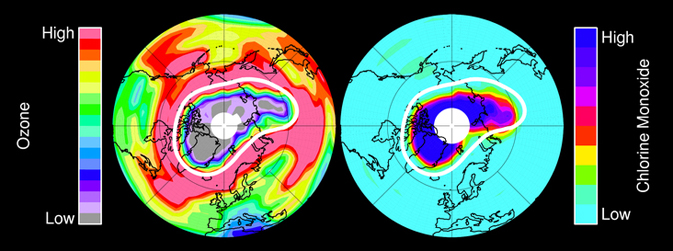You are here
by Emily Chung - CBC News - October 3, 2011
Left: Ozone in Earth's stratosphere at an altitude of approximately 12 miles (20 kilometers) in mid-March 2011, near the peak of the 2011 Arctic ozone loss. Right: chlorine monoxide – the primary agent of chemical ozone destruction in the cold polar lower stratosphere – for the same day and altitude. Image credit: NASA/JPL-Caltech
Environment Canada cuts could disable future Canadian measurements
Unusual winter weather in the atmosphere high above the Earth's surface caused an "unprecedented" loss of protective ozone over the Arctic this year, scientists say.
The ozone layer in the stratosphere, located about 15 to 35 kilometres above the Earth's surface, protects the Earth from the sun's ultraviolet rays and harmful effects such as skin cancer. While an ozone hole has formed in the stratosphere over the Antarctic each spring since the mid 1980s, a paper published in Nature on Sunday marks the first time scientists have reported a comparable loss over the Arctic.
"We've seen something unprecedented," said Kaley Walker, a University of Toronto atmospheric scientists who was part of the international team that conducted the study.
"The amount of depletion and how little ozone there was over certain altitudes is something we haven't seen before."
The team concluded that the huge amount of ozone loss was linked to a period of extreme cold in the stratosphere that lasted 30 days longer this year than in any previously studied Arctic winter.
Cold weather in the stratosphere does not necessarily reflect cold conditions on the surface, and in fact is often linked to warmer surface temperatures. Average temperatures in the Arctic have warmed significantly faster than in other parts of the world in recent decades.
Climate change a main factor
The scientists said further studies are needed to determine exactly what factors caused the cold period in the stratosphere to last so long. But Walker said possibilities include temperatures, wave activity, and other phenomena linked to the amount of energy in the atmosphere — "all resulting from climate change."
NASA scientist Gloria Manney, lead author of the study, said in a statement that the findings imply that if winter temperatures in the stratosphere drop slightly in the future as a result of climate change or other factors, "then severe Arctic ozone loss may occur more frequently."
The scientists first reported in March that ozone loss over the Arctic was set to hit a record. At that time, Walker said, it wasn't clear whether the ozone depletion met the criteria for a hole — the disappearance of ozone down to zero over a certain altitude range. The depletion continued for another month after that.
"We were able to look at it and establish that it was very similar to what had happened in the Antarctic," Walker said.
The amount of ozone loss was comparable to what was seen in the Antarctic, even though spring levels of Arctic ozone were ultimately higher than in the Antarctic because the Arctic typically starts off with more ozone.
The scientists based their findings on data from a combination of:
- Satellite ozone measurements.
- Ground-based ozone measurements, which measure the total amount of ozone from the surface to the top of the atmosphere.
- Balloon-based sonde measurements, which allow researchers to compare measurements at different altitudes.
"Being able to put them all together made for the kind of work that we could do to understand in depth what happened this year," Walker said.
The Canadian data was collected as part of a collaboration between Environment Canada and the University of Toronto, which has been taking extra balloon measurements for two to three weeks each year to validate satellite measurements.
Walker said one more year of the collaboration is planned, and the university is negotiating with the Canadian Space Agency to continue funding them, as the ozone-measuring satellite is still collecting data that needs to be confirmed as reliable.
Environment Canada confirmed in September that its separate ground-based and balloon-based ozone monitoring networks won't be maintained due to budget cuts, but instead will be "consolidated and streamlined" because the department no longer needs the same level of ozone monitoring.
Walker is hopeful that the infrastructure needed to maintain the collaboration will continue to exist.
"These were really important this year. We hope to continue to work with Environment Canada to continue these valuable measurements," she said.
"I'm hoping this exciting winter we've just had will help make the point that there are no redundancies."
Liberal environment critic Kirsty Duncan issued a statement Monday calling on the government to reverse the cuts to Environment Canada's ozone monitoring network in light of the findings about the ozone hole, which she said directly affects Canada.
"It is alarming that cuts are being made at a time when we still do not fully understand the cause of the problem or the future of the ozone layer,” Duncan said.
http://www.cbc.ca/news/world/story/2011/10/03/arctic-ozone-hole.html?cmp=rss
NASA Leads Study of Unprecedented Arctic Ozone Loss
http://www.nasa.gov/topics/earth/features/arctic20111002.html
Unprecedented Arctic ozone loss in 2011 - Abstract - nature.com
Chemical ozone destruction occurs over both polar regions in local winter–spring. In the Antarctic, essentially complete removal of lower-stratospheric ozone currently results in an ozone hole every year, whereas in the Arctic, ozone loss is highly variable and has until now been much more limited. Here we demonstrate that chemical ozone destruction over the Arctic in early 2011 was—for the first time in the observational record—comparable to that in the Antarctic ozone hole. Unusually long-lasting cold conditions in the Arctic lower stratosphere led to persistent enhancement in ozone-destroying forms of chlorine and to unprecedented ozone loss, which exceeded 80 per cent over 18–20 kilometres altitude. Our results show that Arctic ozone holes are possible even with temperatures much milder than those in the Antarctic. We cannot at present predict when such severe Arctic ozone depletion may be matched or exceeded.
http://www.nature.com/nature/journal/vaop/ncurrent/full/nature10556.html




Recent Comments